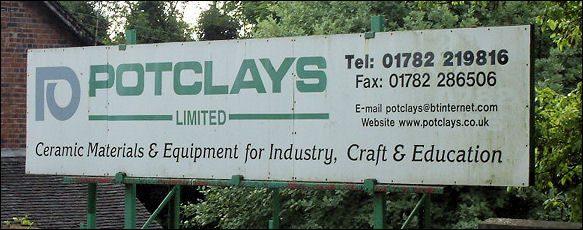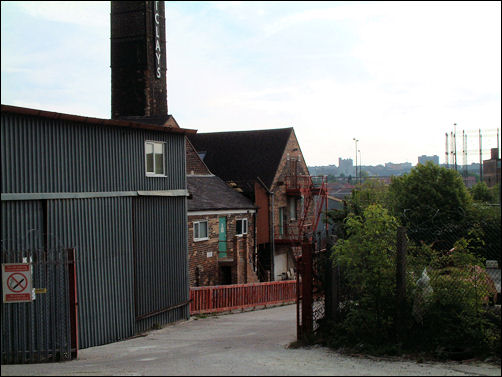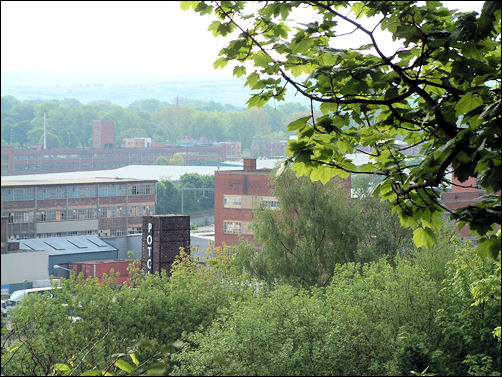At the
bottom of Fowlea Bank the lane slopes into Brick Kiln Lane passing through
the well-known company Potclays Limited where I meet its chairman and
managing director Jonathan Noake who gives me a history of his family
business.

Potclays
“The
company was started by my grandfather William who had been works manager
for Twyfords before he retired. His interest was geology and he had
ideas about producing inexpensive ball clay without having to go to
Cornwall. He went to the South Staffs coalfield and made hundreds of
enquiries with local miners about the quality of clay and discovered it
was white and plastic enough to suit his ideas. The landlord of a pub
called the Swan took him down his cellar and showed him a full seam of
high-grade coal under-laid with the clay he wanted. So he bought the
local mine and sold the coal and clay to sanitary-ware manufacturers in
Stoke on Trent trading under the name The Potter’s Clay and Coal Company
at the Swan Works, named after the pub.”
William
died in 1939 and his son Warbreck Noake took over the businesses. During
the war the company in Brownhills was requisitioned and used as a food
storage depot with the manufacturing side producing nothing but coal. But
in 1944 Warbreck and his wife Helen formed Potclays as a marketing
company. Jonathan continues.
“After
the war a businessman named Bernard Leach developed a successful
Japanese and stoneware product using clay on-site in Devon and Cornwall.
This opened the gates for communes of hippies who set-up studios getting
clay virtually from their back gardens. It was a supply market we
eventually cornered with our own clay during the 1960’s and 70’s. From
this point Potclays became the major merchant moving into kiln-ware and
studio tools. I came into the business in 1969 from which time we
stopped supplying to manufacturers altogether but doubled our turn-over
each year to become biggest single clay supplier to studio and education
outlets and in ceramic hobby-craft goods.”

Some of Potclays
works
I ask
Jonathan about his connection with Etruria Road and Fowlea Bank.
“In the
early 1940’s we rented a yard by the canal basin with a wharf that linked
directly to our Brownhills Company. For quite a while we shipped our clay
from South Staffs to Etruria by canal barge. We even had our own rail
sidings at this time as well. When Downings Brick Company moved to
Chesterton from Etruria we bought their site.”
I recall
there was once a large house at Potclays’ entrance.
“That
would be Basford Lodge,” says Jonathan. “It was a handsome building that I
wanted to develop into showplace offices. But a valuer advised me that it
had unsolvable structural problems so we took it down.”

Etruria valley, the
old Twyford's Works and Potclays - from Fowlea Bank
Halfway
on the bank I meet residents Darryl and Jennifer Porter with their
neighbours David and Jill Cartlidge.
“Things
have changed a lot on the bank over the years and even more so since the
D-Road altered the direction and the movement of traffic. There was a time
when if you got behind a bus or a lorry it’d take ages to get up the old
bank because of its steepness,” says Darryl.
The
Porter’s have lived here for 30 years - “It’s much quieter at the back
since the road has been moved away,” adds Jennifer. “Mind you the traffic
noise at the front is continuous, but you get used to it.”
David and
Jill on the other hand have lived on the bank for 40 years.
“We love
it for its convenience,” says David. “We use the back rather than the
front so I call it Back-Etruria Road.”
Jill
tells of the old days - “Before our time of course,” she smiles,
“there used to be tethering posts at the top for the horses. After it was
diverted quite a few businesses settled near the top.”
David
recalls a dentist’s surgery-cum-house -“A later owner told me that every
time he dug his garden over there was always a spade-full of teeth that
came out with the soil.”
Coal, clay, teeth; what ever next can be dug from Basford Bank?
![]()
![]()
![]()